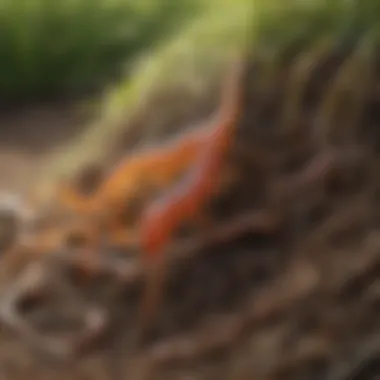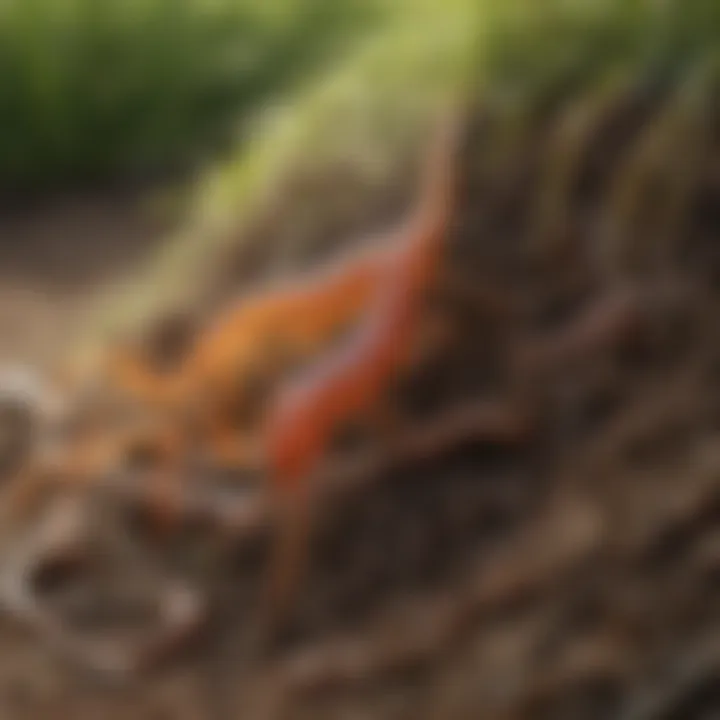Effective Natural Lawn Treatments for Fleas


Intro
Fleas present a challenging problem for many lawn owners. Understanding how to manage these pests naturally can lead to a healthier lawn and a better environment overall. This article discusses several methods to tackle flea infestations without turning to harsh chemicals. By using sustainable practices, homeowners can keep their lawns thriving while effectively controlling flea populations.
Understanding Pests
Definition of Pests
Pests are organisms that cause harm to plants, animals, and humans. In the context of gardens and lawns, fleas are external parasites that feast on the blood of mammals, including pets and humans. They reproduce rapidly and can establish large populations if not managed promptly.
Importance of Pest Identification
Identifying pests is crucial to effective management. Flea larvae develop in grassy areas and can easily thrive in warm and humid conditions. Adults lay eggs in pet bedding or the vicinity of animals. The more you know about their lifecycle, the better you can prevent infestations. Knowing the enemy is the first step in a successful strategy against them.
Prevention Techniques
Home and Garden Preventative Measures
Homeowners can employ simple strategies to minimize flea populations. Regularly mowing your lawn can disrupt flea habitats. Keeping grassy areas short discourages adult fleas from laying eggs. Additionally, creating barriers with mulch around flower beds can deter their spread.
Seasonal Prevention Tips
Fleas are most active during warmer months. It's helpful to implement a routine check on your pets and your lawn in early spring. Using a fine-toothed comb on pets can help capture adult fleas before they proliferate in your yard. Moreover, regularly vacuuming inside your home and washing pet bedding can reduce indoor flea populations, making outdoor treatments more effective.
Eco-Friendly Pest Control Solutions
Overview of Sustainable Practices
An eco-friendly approach emphasizes harmony with nature. Keeping your lawn healthy and diverse can inherently reduce pest issues. Incorporating native plants, ensuring proper soil health, and avoiding synthetic chemicals all contribute to a more resilient ecosystem.
Natural Remedies and Their Effectiveness
Several natural remedies show promise in controlling flea populations:
- Beneficial Nematodes: These microscopic worms attack flea larvae in the soil, providing an effective, chemical-free solution.
- Diatomaceous Earth: This powdery substance can be sprinkled over affected areas. It disrupts the exoskeleton of fleas, leading to dehydration and death.
- Essential Oils: Certain oils, like lavender or cedarwood, act as natural repellents. However, caution is necessary, especially around pets or children.
Natural methods may take time to show effects, but the long-term benefits to the ecosystem are often worth the wait.
Understanding Fleas and Their Lifecycle
Understanding fleas and their lifecycle is essential for effective pest management in lawns. Knowledge of flea biology helps homeowners identify the extent of infestation and choose appropriate natural treatments. By comprehending how fleas behave and reproduce, one can adopt strategies that prevent their development and control their populations efficiently.
Flea Biology and Behavior
Fleas are small, flightless insects belonging to the order Siphonaptera. They thrive as external parasites primarily on mammals and birds, feeding on their blood. A key feature of their biology is their remarkable jumping ability. Adult fleas can leap up to 200 times their body length, enabling them to easily transfer between hosts and environments. Additionally, fleas possess a unique mouthpart adapted for piercing skin and sucking blood, which is crucial for their survival.
Fleas prefer warm, humid environments conducive to their reproduction. They typically remain in areas where their hosts frequent, such as grassy lawns, carpets, and pet bedding. Understanding these behavioral patterns is vital for homeowners as it can inform the best locations to target for treatment.
Identification of Flea Species
Not all fleas are the same. While the cat flea, Ctenocephalides felis, is the most common species found on pets, other species such as the dog flea (Ctenocephalides canis) and the human flea (Pulex irritans) also exist. Identification of flea species can be essential as some species may have different preferences for hosts and habitats.
Homeowners can recognize fleas by their small, reddish-brown bodies, which are flattened sideways. Adult fleas are typically about 1/8 inch in length. To identify fleas, one can use a fine-toothed comb on pets or a white sheet to catch fleas after disturbance. Observing flea feces—small black specks, often referred to as “flea dirt”—is another method of confirming their presence.
Flea Lifecycle Stages
The lifecycle of fleas comprises four distinct stages: egg, larva, pupa, and adult. Each stage presents opportunities for infestation and control.
- Egg: Female fleas lay dozens of eggs daily, which fall off the host into the environment. Eggs are tiny, white, and about 0.5 mm long.
- Larva: After hatching, larvae emerge and develop in dark, moist places. They feed on organic debris, including dried blood and flea feces. This stage lasts from 5 to 20 days, depending on environmental conditions.
- Pupa: Larvae spin cocoons and enter a pupal state, where they can remain for days to months. Pupae are resistant to treatments, making this stage difficult to control.
- Adult: Once conditions are right, adults emerge from the pupae, ready to find a host for blood meals. Adult fleas can live for several months, reinforcing the necessity for ongoing monitoring.


Understanding the lifecycle phases of fleas helps in targeting treatments accordingly, focusing on disrupting their developmental stages to prevent infestations.
Impact of Fleas on Lawns and Pets
Fleas are not just a nuisance; they have a significant impact on both lawns and the pets inhabiting them. Understanding this impact is crucial for homeowners and gardeners. Fleas can negatively affect the health of your lawn as well as the well-being of your pets. By examining the effects of flea infestations and recognizing how they can impact the ecosystem, you can make informed decisions about managing these pests naturally.
Consequences of Infestation
Flea infestations can lead to a host of problems. First, they cause distress for pets, leading to excessive scratching and even skin infections. The bites of fleas are not only irritating but can also transmit diseases such as tapeworms. Moreover, in severe cases, a heavy infestation can lead to anemia, particularly in small animals.
On the lawn, fleas can disrupt the ecosystem, especially if a treatment does not target them effectively. Infestations can result in the decline of beneficial insects, which in turn may affect soil health. A lawn that supports a healthy ecosystem can suffer from decreased vitality when fleas invade.
How Fleas Affect Ecosystem Health
The presence of fleas in a lawn influences more than just pets. They impact the overall balance of the ecosystem. Fleas can contribute to the decline in the population of beneficial nematodes and other insects, which play critical roles in soil aeration and nutrient cycling. The decline of these insects may lead to poorer soil quality and unhealthy grass.
Healthy lawns coexist with a variety of organisms, and fleas disrupt this harmony. It is important to sustain an ecosystem where beneficial organisms dominate to maintain a vibrant and flourishing lawn. Aiming for a flea-free environment will support a diverse range of life forms. This diversity is key for the long-term health of the lawn.
Indicators of Flea Presence
Detecting fleas early is fundamental to managing them effectively. Common indicators of flea presence include:
- Pet Behavior: If your pet is scratching or chewing excessively, it may indicate fleas.
- Flea Dust: This appears as tiny black specks in your pet's fur or on surfaces where they rest.
- Visible Fleas: Adult fleas are small and can often be seen darting across the fur of a pet.
Additionally, dead fleas and flea eggs can sometimes be found on the lawn. Regular inspection of your pet and lawn can help catch flea problems early, before they escalate into severe infestations. Monitor changes in pet behavior and check the environment regularly to maintain a healthy living space, both for your pets and your lawn.
Natural Lawn Treatment Options
Managing fleas naturally not only protects our pets and family but also preserves the environment. Utilizing natural lawn treatment options minimizes harmful chemicals in our surroundings. Each method discussed here has unique benefits and considerations, providing a range of effective strategies to combat flea infestations.
Foreword to Natural Treatment Methods
Natural treatment methods focus on using biological and physical interventions rather than chemical pesticides. They involve safe and often eco-friendly practices. Natural methods can be cost-effective and beneficial for long-term lawn health. The main goal is to create an inhospitable environment for fleas while promoting the well-being of your lawn. Homeowners should consider these methods seriously, as they contribute to sustainability and ecological balance.
Beneficial Nematodes as a Biocontrol Agent
Beneficial nematodes are microscopic worms that can help in controlling flea populations in your lawn. They are naturally occurring in soil, making them a non-invasive solution. When introduced to your lawn, these nematodes search for flea larvae and infect them, leading to their demise.
Using beneficial nematodes involves the following steps:
- Purchase from a trusted supplier: Look for nematodes that are effective against fleas, such as Steinernema feltiae.
- Application: Apply nematodes during the early morning or late afternoon when the soil is moist. They thrive in conditions where the temperature is between 55°F and 77°F.
- Watering: After application, lightly water the area to help them establish.
This method is safe for pets and humans, as these nematodes do not affect other beneficial insects.
Diatomaceous Earth: A Physical Barrier
Diatomaceous earth (DE) consists of fossilized algae called diatoms. This product works as a physical barrier to fleas. When insects come into contact with DE, it damages their exoskeleton, leading to dehydration and death. There are a few important considerations when using diatomaceous earth:
- Choose food-grade DE: This type is safe for pets and plants.
- Application: Spread it in areas where fleas are likely to reside, such as shady spots and near plants. A thin layer should suffice.
- Reapplication: DE needs to be reapplied after heavy rain or watering.
By using DE, homeowners can provide a natural barrier against fleas without risking chemical exposure.
Essential Oils and Natural Repellents
Essential oils can be powerful tools in flea management. Some oils act as natural repellents, making the environment less appealing for fleas. Oils like lavender, peppermint, and tea tree can be utilized. Here are ways to use essential oils:
- Dilution: Always dilute essential oils with a carrier oil before application to avoid skin irritation.
- Sprays: Create a natural flea repellent spray by mixing water, a few drops of essential oil, and a touch of vinegar.
- Diffusion: Using a diffuser can help in keeping fleas away while also adding a pleasant scent to the space.
Note that some essential oils can be toxic to pets, so research thoroughly before use.


Natural Beneficial Insects
Encouraging natural beneficial insects can also help manage flea populations. Insects like ladybugs and lacewings feed on flea larvae and pupae, naturally reducing their numbers. Homeowners can promote beneficial insects by:
- Avoiding pesticides: Chemicals can harm beneficial insect populations.
- Planting diverse flora: A variety of plants attracts different beneficial insects.
- Providing habitat: Leave small patches of undisturbed soil or mulch to create favorable living spaces for these insects.
By enhancing the ecosystem's natural balance, homeowners can effectively reduce flea infestations without the use of harsh chemicals.
Cultural Practices for Flea Management
Cultural practices play a crucial role in managing flea populations in lawns. These practices focus on creating an environment that is less hospitable to fleas and more supportive of healthy plants and ecosystems. By understanding and implementing these methods, homeowners can naturally reduce the prevalence of fleas without relying on chemical interventions. Effective cultural practices can enhance lawn health, reduce infestation chances, and lead to an overall more sustainable approach in pest management.
Maintaining Lawn Health
A healthy lawn is your first line of defense against fleas. When grass and plants are strong, they are better able to resist pests. To maintain lawn health, regular maintenance routines are essential. This includes fertilization, appropriate watering schedules, and pest monitoring. Choosing the right grass type for your climate can also make a difference. A healthy, dense lawn can prevent flea populations from establishing themselves, as it offers fewer opportunities for fleas to thrive in bare or sparse areas.
Mowing and Watering Techniques
Proper mowing and watering techniques can directly influence flea populations in your lawn. Mowing your lawn at the correct height is vital. Grass that is cut too short can weaken root systems, making it easier for pests to invade. Aim to mow at a height of about three inches. This encourages healthy root growth and creates shade, which can impede flea development. Watering should be done in the early morning or late afternoon to minimize evaporation but also to prevent excess moisture, which can encourage flea breeding. Watering frequently but lightly can promote healthy growth while reducing moisture levels that fleas prefer.
Mulching and Aeration
Mulching serves as an effective means to combat fleas while providing additional benefits to your lawn. Applying organic mulch around garden beds can suppress fleas and other pests, as well as retain moisture and provide nutrients back to the soil. It is important to choose the right type of mulch, such as cedar, which has natural insect-repelling properties.
Aeration, on the other hand, involves perforating the soil with holes to allow air, nutrients, and water to penetrate deeper into the roots. This process improves overall lawn health and decreases compacted soil, creating an unfavorable environment for fleas. Aerating the lawn can be done with either manual tools or powered equipment, depending on the size of the area and the severity of soil compaction.
"Healthy lawns mean fewer fleas. Easier management and a thriving ecosystem can be achieved through proper care."
Utilizing these cultural practices will not only help manage existing flea populations but also contribute positively to the overall health of your lawn. It is a proactive way to create an environment less suitable for pests, ensuring a more sustainable and natural lawn treatment strategy.
Monitoring and Maintaining Treatment Effectiveness
Monitoring and maintaining treatment effectiveness is critical in managing flea populations naturally. Without proper evaluation, one cannot gauge whether the chosen strategies are successful or need adjustment. This could lead to ineffective treatments that waste resources and leave your lawn vulnerable to flea infestations.
Establishing a consistent monitoring routine helps detect early signs of flea activity and promotes timely interventions. Additionally, understanding treatment success allows homeowners to feel reassured in their approaches.
Establishing a Monitoring Routine
To effectively monitor flea activity, a routine is necessary. You should inspect your lawn regularly for flea signs. Look for an increase in flea activity, such as fleas hopping on pets or flea dirt on the ground.
- Check under bushes and shaded areas, where fleas may thrive.
- Use flea traps to help in detection.
- In warmer months, consider checking weekly.
A calendar or logbook can help in tracking inspections and specific observations. Documenting the dates and conditions of each check will assist in spotting patterns relating to treatment effectiveness.
Assessing Treatment Results
After implementing a natural treatment method, it is vital to assess its results. Evaluate the lawn and pet situations. Compare conditions before and after treatment application. Ask specific questions:
- Are fleas less noticeable on pets?
- Has there been any visible decrease in flea dirt?
- How has the overall health of the lawn changed?
Take into account any environmental factors as well. Weather and soil conditions can influence flea population dynamics. An increase in moisture, for example, could promote flea breeding.
Adjusting Strategies Based on Observations
Once you have assessed the outcomes of your treatments, be ready to adjust your strategies as needed. If certain methods do not prove effective, consider alternatives. This may involve changing timing, applying different natural treatments, or enhancing cultural practices surrounding lawn health.
- If beneficial nematodes don’t seem to work, explore other natural treatments like diatomaceous earth or essential oils.
- If there's still evidence of fleas, increase monitoring frequency.
Continuous refinement leads to the best outcomes and maintains your lawn's health. As you make adjustments, keep track of changes and stay attuned to your lawn's response.


Key Takeaway: Monitoring and adjusting strategies ensure a persistent and adaptable approach, essential for effective flea control.
Addressing Common Misconceptions about Flea Treatments
Understanding flea treatments requires a critical examination of widespread beliefs that often lead to confusion. By addressing misconceptions, we can create a clearer perspective on how to manage flea populations naturally. Misunderstandings may lead homeowners to underestimate the potential effectiveness of natural methods or over-rely on chemical pesticides.
Recognizing the reality of flea management is beneficial for fostering healthier lawns and environments. Effective flea management is not simply about eliminating the pests; it involves creating a sustainable ecosystem where the fleas are kept in check without harming beneficial organisms. It also enhances the well-being of pets and local wildlife.
Dispelling Myths Related to Natural Solutions
One common myth is that natural solutions lack efficacy compared to chemical options. While some may assume that natural means less effective, many methods show promising results. For instance, beneficial nematodes can significantly reduce flea larvae in the soil. Similarly, diatomaceous earth serves as a mechanical barrier that disrupts flea life stages.
Another misconception is that natural solutions are time-consuming and labor-intensive. In reality, many natural treatments require minimal application and can be integrated into regular lawn care routines. Homeowners can plan their treatments around existing practices, reducing effort while effectively targeting fleas.
"Natural solutions are often dismissed as slow or weak, but they bring long-term sustainability to lawn health and pest control."
Educating oneself on how these solutions work creates trust in their usage. Knowledge about specific techniques can empower homeowners to make informed decisions, thus changing their perspective on the capabilities of natural methods.
Comparative Effectiveness of Natural vs. Chemical Treatments
When comparing natural and chemical treatments, it is essential to consider several factors. Chemical pesticides often promise immediate results; however, they may come with adverse effects on the ecosystem. Chemical solutions might kill not only fleas but also helpful insects and plants.
Natural treatments, though sometimes slower to show results, typically provide a broader range of benefits. For example, using essential oils can repel fleas while also promoting a pleasant aroma in the garden. Furthermore, many natural options, such as beneficial insects, offer a cycle of biodiversity that chemical treatments disrupt.
Additionally, natural treatments often pose less risk to pets and children, making them a safer choice for households. Despite their slower action, natural solutions contribute to a healthier lawn environment, which can lead to sustainable pest management in the long run.
In summary, while chemical approaches may seem tempting due to rapid outcomes, understanding long-term effects and the holistic benefits of natural treatments is vital. By dispelling myths and highlighting the comparative advantages of natural solutions, homeowners can make educated choices that align with their values and environmental considerations.
Sustainability in Pest Management
Sustainability in pest management refers to the development and implementation of practices that not only target the immediate issues of pest infestations, such as fleas, but also ensure the long-term health of the ecosystem. This article underscores the importance of using sustainable methods for flea management, aiming to inform homeowners and gardeners of their role in fostering a balanced environment. By focusing on techniques that do not rely on harmful chemicals, individuals can protect beneficial insect populations, enhance soil health, and contribute to overall biodiversity.
The integration of sustainability in pest management strategies is vital. Not only does it minimize the risks associated with chemical pesticides, but it also reduces the chance of developing pest resistance. Fleas, like many pests, can adapt quickly to treatments. When chemical solutions dominate, they can lead to quicker adaptations, making traditional interventions ineffective over time. In contrast, sustainable practices emphasize a holistic approach that can include biological control, habitat manipulation, and cultural practices, thereby decreasing reliance on quick-fix solutions.
Benefits of Sustainable Practices
Sustainable practices in pest management offer several benefits:
- Environmental Health: By utilizing natural methods, such as beneficial nematodes or essential oils, practitioners limit the introduction of toxic substances into the soil and water systems, preserving the health of the surroundings.
- Economic Viability: Long-term reduction in chemical use can lower costs associated with purchasing pesticides. Moreover, investing in natural treatment methods can provide savings over time as the ecosystem becomes more self-sustaining.
- Biodiversity Promotion: Encouraging a diverse set of organisms within the lawn ecosystem can help keep flea populations in check naturally. Healthy ecosystems with a variety of species are generally more resilient to pest threats.
In addition to these, sustainable lawn practices can improve the aesthetic value of gardens. Applying organic treatments often leads to greener, more vibrant lawns that are also safer for families and pets.
Long-Term Ecological Impacts
The long-term ecological impacts of sustainable pest management can be profound. By reducing the reliance on chemical pesticides, homeowners can nurture a healthier ecosystem. This shift can lead to improved soil structure and fertility, as natural methods often enhance the microbial community within the soil. A robust microbial population can facilitate better nutrient cycling and overall soil health, promoting the growth of resilient plants that can withstand pest pressures.
Sustainability also supports wildlife. A well-managed lawn can become a habitat for various beneficial insects, birds, and other wildlife, enhancing biodiversity in urban and suburban settings. This biodiversity serves as a natural check against pests like fleas, as it includes predators that can help keep their populations under control.
"Implementing sustainable practices in pest management not only aids in effective flea control but also nurtures our environment towards longevity and resilience."
Adopting sustainable lawn treatment practices ensures that pest management is not just a temporary fix. Instead, it promotes an enduring solution that contributes to healthier ecosystems for generations to come. As awareness of the importance of ecological balance grows, incorporating sustainable strategies into home management becomes increasingly vital.
Finale
Summary of Key Points
In reviewing the article, several key points emerge about natural flea management:
- Fleas have a complex lifecycle and understanding it is crucial for effective treatment.
- Natural treatments can provide a safe alternative to chemical pesticides, protecting both pets and beneficial insects.
- Sustainable practices in lawn care contribute not only to flea management but to the overall health of the ecosystem.
- Regular monitoring and cultural techniques enhance the effectiveness of chosen treatments.
Final Thoughts on Natural Flea Management
Adopting natural flea management strategies is more than just addressing a pest issue; it reflects a commitment to ecological integrity. Homeowners should consider integrating multiple approaches, fostering a comprehensive system of pest control. By prioritizing knowledge and environmental responsibility, it is possible to maintain a beautiful lawn while ensuring the health of both pets and local wildlife. Encouragingly, with diligence and awareness, natural solutions can lead to significant reductions in flea populations, ultimately offering peace of mind to those who care for and manage their outdoor spaces.
"Sustainable practices are not just good for the environment; they protect our households, gardens, and the pets we cherish."
Embracing these strategies not only contributes to immediate results but also supports long-term ecological balance.



